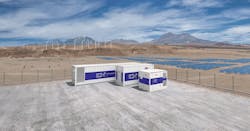Rolls-Royce to Expand Battery Production Capacity to Meet Demand for Microgrids
A Rolls-Royce business unit is increasing its capacity for producing containerized battery packs in response to growing demand for microgrids.
The plan to expand capacity will see three former Siemens factory halls rebuilt which will allow the fitting of battery modules to several 40-ft containers simultaneously, as well as subsequent testing.
From 2021 the MTU EnergyPacks will be manufactured in the Siemens-Technopark in Ruhstorf, Bavaria, where Rolls-Royce has a production site. Image courtesy of Rollls-Royce
The MTU EnergyPacks will be manufactured in the Siemens-Technopark in Germany’s Bavaria.
This new production capacity will be available from early 2021. The expanded facilities will also include a showroom, warehouse and office space.
“To respond to the importance that microgrids are assuming as a young but highly promising line of business, we’re setting up a new production facility just for our battery containers,” says Armin Funck, general manager of MTU Onsite Energy in Ruhstorf where most MTU EnergyPacks are currently produced.
As Wolfgang Boller, spokesperson for Rolls-Royce Power Systems, tells Microgrid knowledge: “Since we are ramping up this business and we are expecting more demand in the future we looked for another production facility nearby the existing facility which is our specialist for containers. The Siemens Technology Park was the perfect offer to us.”
With the tenancy agreement just signed, the expansion of the production site will form part of Rolls-Royce’s new Microgrid Solutions division. This was established by Rolls-Royce following the acquisition of a majority stake in Berlin-based energy storage specialist Qinous. Along with lithium-ion batteries, the MTU EnergyPack houses an electronic control unit, transformers, and cooling equipment to form a complete energy storage system.
Boller adds: “Currently we are able to produce 30 to 40 containers per year. With the new facility we will be able to enhance the production significantly and we are able to adapt the volume depending on the order volume.”
Track news about microgrids and batteries. Subscribe to the free Microgrid Knowledge newsletter.







